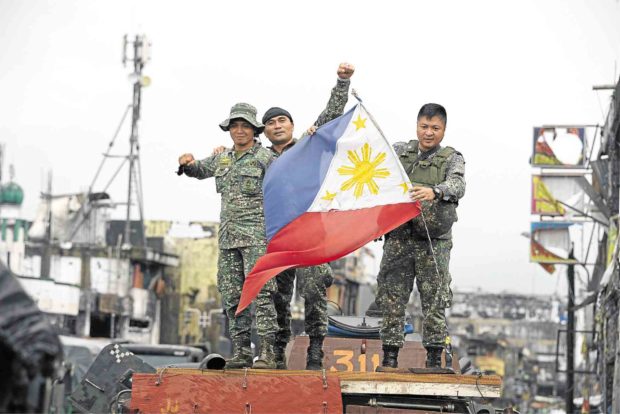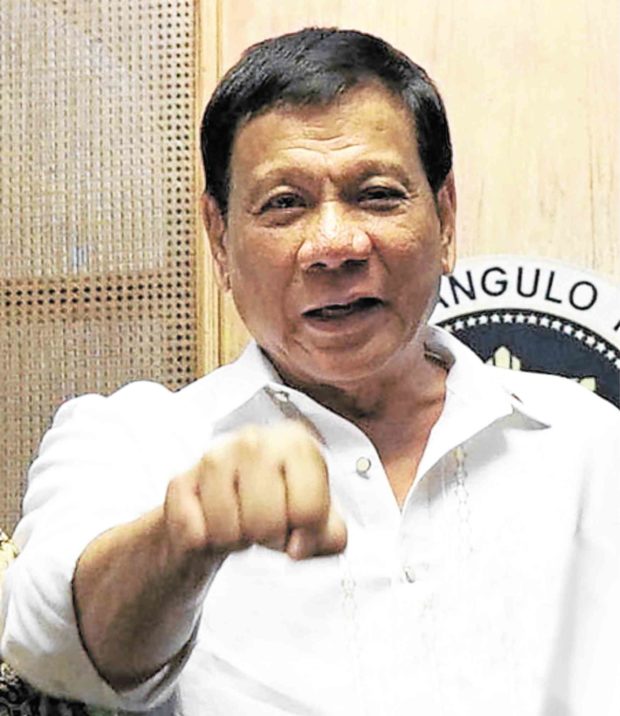Marawi ‘liberated’ from terrorists but battle drags on
Published: 2:04 p.m., Oct. 17, 2017 | Updated: 12:04 a.m., Oct. 18, 2017
MARAWI CITY — President Rodrigo Duterte on Tuesday declared Marawi “liberated from terrorist influence,” but the military said the five-month battle against gunmen loyal to the Islamic State (IS) jihadist group was not yet over.
Hours before Mr. Duterte arrived in Barangay Bangolo here after 1 p.m., gunfire rang out sporadically and explosions thudded as government troops fought the leaderless terrorists still holed up in the city.
Speaking to rain-soaked soldiers a day after the killing of the last two leaders of the terrorist alliance Dawla Islamiya, Mr. Duterte said it was time to heal the wounded and rebuild the city of 200,000 people.
“Ladies and gentlemen, I hereby declare Marawi City liberated from terrorist influence. That marks the beginning of rehabilitation,” Mr. Duterte said on the 148th day of the fighting.
Article continues after this advertisementFighting continues
Spokespersons for the military later clarified that the fighting against a few remaining terrorists continued along with efforts to rescue hostages.
Article continues after this advertisement“We are going to get them very soon. We’re making sure no hostages and fighters are left,” said Col. Romeo Brawner Jr., deputy commander of the military task force fighting the terrorists.
Asked by reporters if Mr. Duterte’s declaration was symbolic, Brawner said: “Yes, because we cannot really say that [the area] is 100 percent cleared. Even when World War II ended and liberation had been declared, fighting continued. That is also what’s happening here.”
Speaking to The Associated Press (AP), Gen. Eduardo Año said Mr. Duterte’s statement meant the threat from the terrorists, who occupied Marawi for five months, was substantially over.
“They’re leaderless and they have no more organization,” the Armed Forces chief of staff said. “There are still skirmishes.”
Isnilon Hapilon, a leader of the Abu Sayyaf bandit group who was said to be the “emir,” or leader, of IS in Southeast Asia, and Omarkhayam Maute of Lanao del Sur’s Maute terrorist clan, were killed in a targeted operation on Monday and their bodies had been recovered and identified, the military said.
According to Maj. Gen. Restituto Padilla Jr., spokesperson for the military, there were 20 to 30 terrorists left in Marawi, including six to eight foreign fighters.
They have about 20 hostages, including women and children, Padilla said.
“There is no way that they can get out anymore, there is no way for anyone to get in,” he said in a television interview.
“So choking them to death at this point will be very key for our troops to do since the area is very much contained and very controlled,” he added.
Surrender
Malacañang called on the remaining terrorists to surrender after the deaths of their last two leaders.
“With terrorist leaders gone, we call on all fighters to cease further resistance and violence and return to the road of peace,” presidential spokesperson Ernesto Abella told a press briefing.
“This is also the call of our Muslim leaders, our imams,
ARMM (Autonomous Region in Muslim Mindanao), MNLF (More National Liberation Front), MILF (More Islamic Liberation Front) chiefs, and the leaders of Muslim nations and this is the plea of your families, friends and communities,” he said.

DAY OF CELEBRATION Waving a flag, soldiers aboard an armored personnel carrier celebrate their victory amid gunfire and explosions in Marawi City. —AFP
“Let us restore peace and rebuild our land,” he added.
Abella said Mr. Duterte’s declaration marked the beginning of the reconstruction and rehabilitation of Marawi.
Lifting of martial law
“Our ground commanders will determine if it is safe for residents to return to the city, as there may still be traps and unexploded ordnance in some areas,” he said.
“We will defer to their assessment and await their recommendation,” he added.
Padilla said consultations would be held to determine whether martial law, which Mr. Duterte clamped on Mindanao on May 23, should be lifted, as there were other groups “sympathetic” to the Maute and Abu Sayyaf terrorists.
“There still remains a part of the network that continues to exist in other parts of Mindanao like Jolo, Tawi-Tawi, Basilan and other parts of Lanao as well as Maguindanao and Cotabato, which needs to be addressed continuously for that threat to be managed,” Padilla said.
He said those groups could lay siege to another major urban area or bomb and harass other communities.
Defense Secretary Delfin Lorenzana said the lifting of martial law in Mindanao would be decided before the end of October.
The 148-day occupation of Marawi by the IS-inspired Maute and Abu Sayyaf gunmen marked the Philippines’ biggest internal security crisis in years.
It began on May 23 when gunmen from the two terror groups, backed by several foreign fighters, mostly from Indonesia and Malaysia, rampaged across Marawi and seized large parts of the city to establish an IS enclave in Southeast Asia.
More than 1,000 people have been killed in the fighting for control of the city, including more than 800 terrorists.
Philippine flags hung on Tuesday from pockmarked buildings and houses, their roofs either blasted away or riddled with gunshot holes.
Soldiers stood guard in front of some buildings and at intersections where battle debris had been shoveled to the side.
Malaysian militant
A top Malaysian militant, Mahmud Ahmad, who uses the nom de guerre Abu Handzalah and is a close associate of Hapilon, has not been found and is among the remaining terrorists being hunted by the military.
Padilla said Mahmud, a former professor at the University of Malaysia in Kuala Lumpur, had been in Marawi since the start of the fight and the military believed he was still there.
The authorities could not be certain, however, but saw him as no threat.
“Doctor Mahmud is an academic, he’s not a fighter,” Padilla said. “We don’t feel he is a problem.”
Padilla said the conflict in Marawi had cost the military at least P2 billion.
After destroying Hapilon’s Abu Sayyaf faction and the Maute group, Año said the military’s next targets would be the remaining Abu Sayyaf bandits in Sulu and Basilan provinces, the Bangsamoro Islamic Freedom Fighters (BIFF) in Central Mindanao and the communist New People’s Army (NPA).
He said the military’s objective was to finish the Abu Sayyaf and the BIFF by the end of 2017.
“So this will continue. There will be no letup. It’s about time [we finished] these terrorists here in Mindanao,” he said.
As for the NPA, Lorenzana said the military would intensify operations against the armed wing of the Communist Party of the Philippines.
Peace talks between the government and the communist rebels collapsed earlier this year, but there were reports about efforts to revive the process. —WITH REPORTS FROM PHILIP C. TUBEZA, JEANNETTE I. ANDRADE, NESTOR CORRALES AND THE WIRES /kga /pdi /atm
